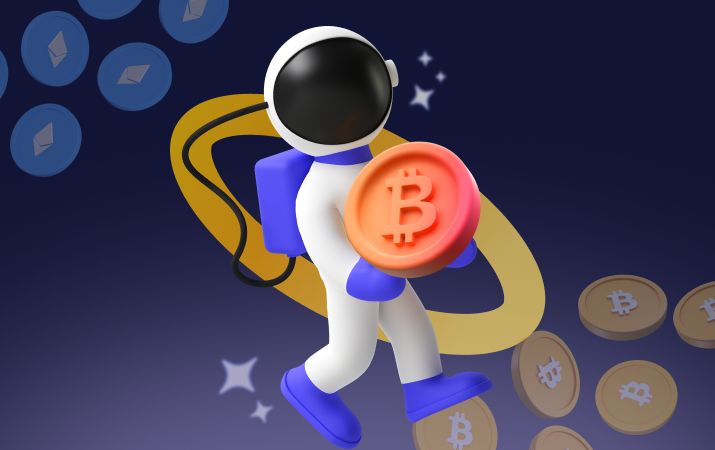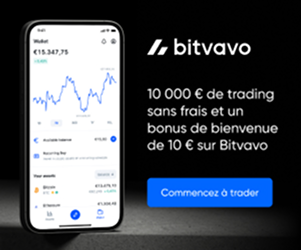Introducing Lisk
Lisk (LSK) is an altcoin created in 2016 by Max Kordek and Olivier Beddows. Their main aim was to compete with Ethereum, while creating a more accessible ecosystem for developers and users. As a result, it is possible to use the JavaScript language to code decentralised applications (DApps) on the network.
The Lisk blockchain is based on a "proof of stake" system rather than a "proof of work" system. With this fairly recent validation consensus, it is no longer the members with the most powerful hardware who are authorised to add blocks, but those with the most tokens. These validators are called "forgers": they are responsible for "forging" the Lisk. This term replaces "mining" in the vocabulary of this network.
Only 101 principal "forgers" have the power to validate blocks. They are freely elected "delegates", based in particular on the number of LSK tokens they possess. This is the network's native currency. These tokens must be exchanged for Bitcoins (BTC) or Ethers (ETH).
To obtain LSK tokens, you need to buy one of these two cryptocurrencies on exchange platforms that accept the euro, such as Coinbase or Coinhouse. After that, there are many platforms where you can exchange Bitcoins or Ethers for Lisk, such as Binance, Upbit or HitBTC.
Introducing Lisk
Lisk (LSK) is an altcoin created in 2016 by Max Kordek and Olivier Beddows. Their main aim was to compete with Ethereum, while creating a more accessible ecosystem for developers and users. As a result, it is possible to use the JavaScript language to code decentralised applications (DApps) on the network.
The Lisk blockchain is based on a "proof of stake" system rather than a "proof of work" system. With this fairly recent validation consensus, it is no longer the members with the most powerful hardware who are authorised to add blocks, but those with the most tokens. These validators are called "forgers": they are responsible for "forging" the Lisk. This term replaces "mining" in the vocabulary of this network.
Only 101 principal "forgers" have the power to validate blocks. They are freely elected "delegates", based in particular on the number of LSK tokens they possess. This is the network's native currency. These tokens must be exchanged for Bitcoins (BTC) or Ethers (ETH).
To obtain LSK tokens, you need to buy one of these two cryptocurrencies on exchange platforms that accept the euro, such as Coinbase or Coinhouse. After that, there are many platforms where you can exchange Bitcoins or Ethers for Lisk, such as Binance, Upbit or HitBTC.
In a nutshell: Lisk explained in 5 key points
Lisk is an altcoin created in 2016 by Max Kordek and Olivier Beddows.
Its blockchain is based on a "proof of stake" system called Delayed PoS. The choice of "forgers" is based on the possession of tokens rather than the power of their hardware.
Lisk enables developers to code in JavaScript.
The LSK token is its native currency.
LSK tokens cannot be purchased directly: they must be exchanged for Bitcoins or Ethers.
What is the Lisk exchange rate?
Lisk price
Elements of analysis
Following in the footsteps of Bitcoin, Lisk has been on an upward trend since the beginning of 2021. After this sustained trend, a sharp fall was seen from 17 April onwards. From 25 April, a new rally seemed to be taking shape. The price has been rising steadily, from $1.2671 on February 1 to around $5 since April.
Why is the price rising?
An upcoming update
Lisk has announced that it will be updating the application that manages its blockchain protocol, Lisk Core. This version 3.0.0 should correct a number of bugs, offer more possibilities to developers, and improve the stability and security of the network.
Lisk.js 2021: a highly anticipated conference
Every year, the Lisk teams organise a conference: Lisk.js. The 2021 edition will take place on 21 and 22 May. The conferences scheduled for this year's Lisk.js are particularly important for the future of altcoin. Its research team is expected to introduce new parameters that will permanently alter the way the decentralised network operates. They should in turn have a positive influence on the Lisk price. Here we take a look at two of these changes.
New features for decentralised applications
As we have seen, the project aims to facilitate the creation of decentralised applications (DApps) by means of a JavaScript-based development kit. This language is very familiar to developers and less complex to learn than Solidity, used by Ethereum.
These applications are unique in that they each run on their own sidechain. In other words, they are entirely independent and autonomous from the Lisk blockchain. This increases the speed of operations on the mainchain, but also strengthens its security: in the event of a hardfork, only the sidechain needs to be modified. Similarly, each sidechain can be customised and optimised according to the needs of the developer.
Lisk plans to further simplify DApp programming, offering ready-to-use application templates from 2021, which will greatly reduce the workload for developers.
An interoperable ecosystem from 2021
The second major change concerns interoperability. This is a key concept in the field of cryptocurrencies, and is at the heart of much of the research into blockchains. Today, blockchains are largely compartmentalised, meaning that they are completely independent of each other. For example, the Bitcoin blockchain cannot share information with the Ethereum blockchain, and vice versa. This lack of interoperability is preventing the democratisation of the blockchain system. It is essential to the implementation of decentralised finance (DeFi), for example.
Lisk plans to make its ecosystem fully interoperable in 2021. This will make it possible to exchange data and tokens with other existing blockchains, as well as directly between Lisk sidechains. This should speed up operations on its network and enable the creation of new, innovative decentralised applications.
In short: 2 events could trigger the growth of Lisk
The rise in the Lisk share price appears to be underpinned by two major announcements:
An update to the programme on which Lisk is based, called 'Lisk Core', has been announced for 2021. This should improve the experience of both users and developers.
The 2021 edition of the Lisk.js conference will take place on 21 and 22 May. This is a highly anticipated event for developers and blockchain experts. It will enable Lisk to introduce some decisive changes.
Lisk partners
Lisk entered into a partnership with Microsoft in 2016, which uses its blockchain as a service for its Azure cloud application.
Its partners, advisors and contributors have secured 3% of the first distributed tokens.
Our opinion on Lisk: should you invest?
Our predictions for the Lisk share price are mixed. The pandemic has had a major impact on altcoins, which now need to prove themselves very quickly if they are not to disappear. While the Lisk price has been rising since the start of the year, the cryptocurrency still needs to find its place in the decentralised applications market, where Ethereum is still the leader. It seems appropriate to keep an eye on the Lisk price in the coming weeks, particularly when their new services are rolled out.
Lisk is an altcoin created in 2016 by Max Kordek and Olivier Beddows.
Its blockchain is based on a "proof of stake" system called Delayed PoS. The choice of "forgers" is based on the possession of tokens rather than the power of their hardware.
Lisk enables developers to code in JavaScript.
The LSK token is its native currency.
LSK tokens cannot be purchased directly: they must be exchanged for Bitcoins or Ethers.
What is the Lisk exchange rate?
Lisk price
Elements of analysis
Following in the footsteps of Bitcoin, Lisk has been on an upward trend since the beginning of 2021. After this sustained trend, a sharp fall was seen from 17 April onwards. From 25 April, a new rally seemed to be taking shape. The price has been rising steadily, from $1.2671 on February 1 to around $5 since April.
Why is the price rising?
An upcoming update
Lisk has announced that it will be updating the application that manages its blockchain protocol, Lisk Core. This version 3.0.0 should correct a number of bugs, offer more possibilities to developers, and improve the stability and security of the network.
Lisk.js 2021: a highly anticipated conference
Every year, the Lisk teams organise a conference: Lisk.js. The 2021 edition will take place on 21 and 22 May. The conferences scheduled for this year's Lisk.js are particularly important for the future of altcoin. Its research team is expected to introduce new parameters that will permanently alter the way the decentralised network operates. They should in turn have a positive influence on the Lisk price. Here we take a look at two of these changes.
New features for decentralised applications
As we have seen, the project aims to facilitate the creation of decentralised applications (DApps) by means of a JavaScript-based development kit. This language is very familiar to developers and less complex to learn than Solidity, used by Ethereum.
These applications are unique in that they each run on their own sidechain. In other words, they are entirely independent and autonomous from the Lisk blockchain. This increases the speed of operations on the mainchain, but also strengthens its security: in the event of a hardfork, only the sidechain needs to be modified. Similarly, each sidechain can be customised and optimised according to the needs of the developer.
Lisk plans to further simplify DApp programming, offering ready-to-use application templates from 2021, which will greatly reduce the workload for developers.
An interoperable ecosystem from 2021
The second major change concerns interoperability. This is a key concept in the field of cryptocurrencies, and is at the heart of much of the research into blockchains. Today, blockchains are largely compartmentalised, meaning that they are completely independent of each other. For example, the Bitcoin blockchain cannot share information with the Ethereum blockchain, and vice versa. This lack of interoperability is preventing the democratisation of the blockchain system. It is essential to the implementation of decentralised finance (DeFi), for example.
Lisk plans to make its ecosystem fully interoperable in 2021. This will make it possible to exchange data and tokens with other existing blockchains, as well as directly between Lisk sidechains. This should speed up operations on its network and enable the creation of new, innovative decentralised applications.
In short: 2 events could trigger the growth of Lisk
The rise in the Lisk share price appears to be underpinned by two major announcements:
An update to the programme on which Lisk is based, called 'Lisk Core', has been announced for 2021. This should improve the experience of both users and developers.
The 2021 edition of the Lisk.js conference will take place on 21 and 22 May. This is a highly anticipated event for developers and blockchain experts. It will enable Lisk to introduce some decisive changes.
Lisk partners
Lisk entered into a partnership with Microsoft in 2016, which uses its blockchain as a service for its Azure cloud application.
Its partners, advisors and contributors have secured 3% of the first distributed tokens.
Our opinion on Lisk: should you invest?
Our predictions for the Lisk share price are mixed. The pandemic has had a major impact on altcoins, which now need to prove themselves very quickly if they are not to disappear. While the Lisk price has been rising since the start of the year, the cryptocurrency still needs to find its place in the decentralised applications market, where Ethereum is still the leader. It seems appropriate to keep an eye on the Lisk price in the coming weeks, particularly when their new services are rolled out.







